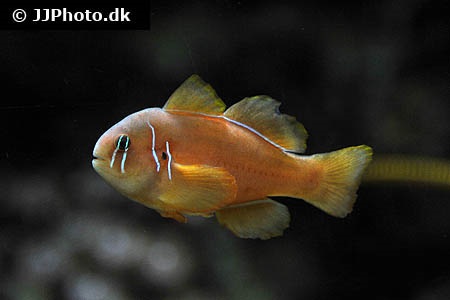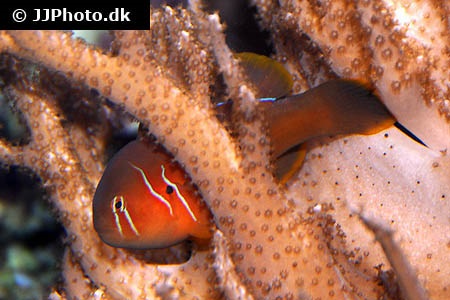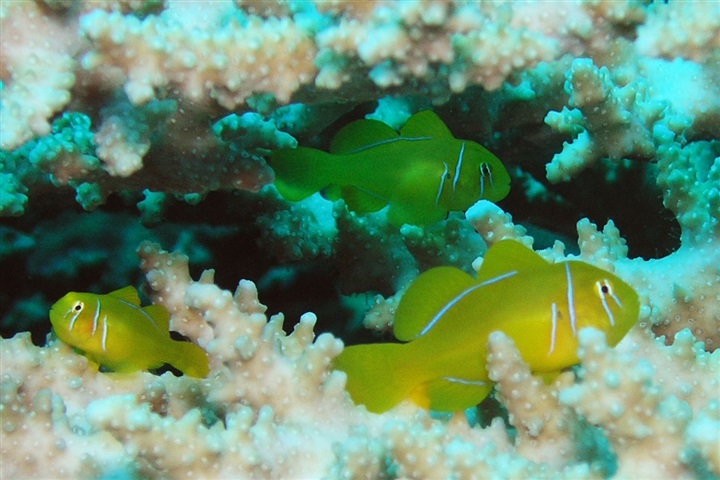Gobiodon citrinus
| Latin name | Gobiodon citrinus - (Rüppell, 1838) |
|---|---|
| Local name | Poison goby |
| Family | Gobiidae - Gobiodon |
| Origin | East Indian Ocean, West Indian Ocean, Australia, The Red Sea, Indonesia, East Pacific, Central/West Pacific |
| Max length | 6 cm (2.4") |
| Minimum volume |
50 l (13 gal) |
|---|---|
| Hardiness |
Average |
| Suitable for aquarium |
Suitable with care |
| Reef safe |
Reef safe with caution |
| Aggressiveness | Docile but might be aggressive towards similar species |
| Recommended |
Small crustaceans (Krill, mysis, artemia...) Small polyp stone coral (SPS) Zooplankton (Cyclops, pods...) |
|---|
This species can be kept in a small tank, if it is specifically equipped to meet its needs.
It is recommended however, to keep it in an aquarium which is larger then described above.
This species is very sensitive during transportation and acclimatizing into the aquarium.
There is a greater chance of success with this species if one can supply a living feed to allow it to adapt to the tank.
Thrives best in an aquarium with Acropora as it likes hiding in amongst its branches.
When there are many SPS and only a few of these fish, corals won`t be damaged. When the fishes nibble at the corals too much, or if the corals are few or small, damage can be caused.
In case of a pair they can sometimes lay eggs on the underside of e.g. Acropora branches.
This species can live as a pair (male and female).
This species is very shy and docile, so one should be careful when keeping it with more aggressive fish.
Gobies (Gobiidae) are generally small fish, which live close to the bottom. Many of the species are fairly hardy and well suited to aquaria. The behaviour of the different kinds of Gobies varies greatly and some can be very interesting.
The most common types of Gobies in aquaria are the following:
Sand eating Gobies (Amblygobius, Koumansetta and Valenciennea)
Sand eaters filter the sand through their mouths and out of their gills.
They are generally bigger than other Gobies, but they are usually peaceful, so size is not a problem.. They can however be aggressive towards their own species.
One must be aware that they can eradicate the micro life in the substrate when the tank is too small. If there is not enough live food in the sand, it can be difficult to ensure the fish stay in good condition, as they require frequent feeding.
They may spread sand across the corals when they eat.
Shrimp Gobies (Amblyeleotris, Cryptocentrus and Stonogbiops)
Shrimp Gobies have a symbiotic relationship with Pistol shrimps, but one must first find out which species can live together.
The shrimp and Goby live together in a small hole in the sand or under a stone where the shrimp maintains the hole, so it will not collapse over time. The Goby helps by looking out for enemies, since the shrimp does not see well in sunlight, as it will have become accustomed its vision to the darkness of the hole.
Neon Gobies (Elacatinus/Gobiosoma)
Thesef Gobies are very small and like the Cleaner Wrasse, it eats parasites off other fish.
These Gobies are easier to keep alive in the aquarium than Cleaner Wrasses, as they can eat a wide range of foods.
Clown Gobies (Gobiodon)
These fish are very small and therefore suitable for small aquariums. Clown Gobies will often hide inbetween the branches of stony corals, like Acropora for example.
They generally eat many types of food, as long as it is small enough.
| Aquarium trade | Yes |
|---|---|
| Distribution | Indo-West Pacific: Red Sea south to Delagoa Bay, Mozambique and east to Samoa, north to southern Japan, south to the Great Barrier Reef. |
| English common names |
Lemon coralgoby Lemon coral-goby Four-bar maori goby Fourbar goby Citron goby |
| Danish common names |
Citronkutling |
Henry C. Schultz. 2002. Let's Clown Around With More Gobies: The Gobiodon Species - Reefkeeping Magazine - (English)
Scott W. Michael. Reef Aquarium Fishes: 500+ Essential-to-know Species - TFH Publications / Microcosm Ltd. - (English)
James W. Fatherree. 2011. Aquarium Fish: A Look at the Gobies - Advanced Aquarist - (English)
Bob Fenner. "True" or Combtooth Gobies, the Family Gobiidae - Wet Web Media - (English)






